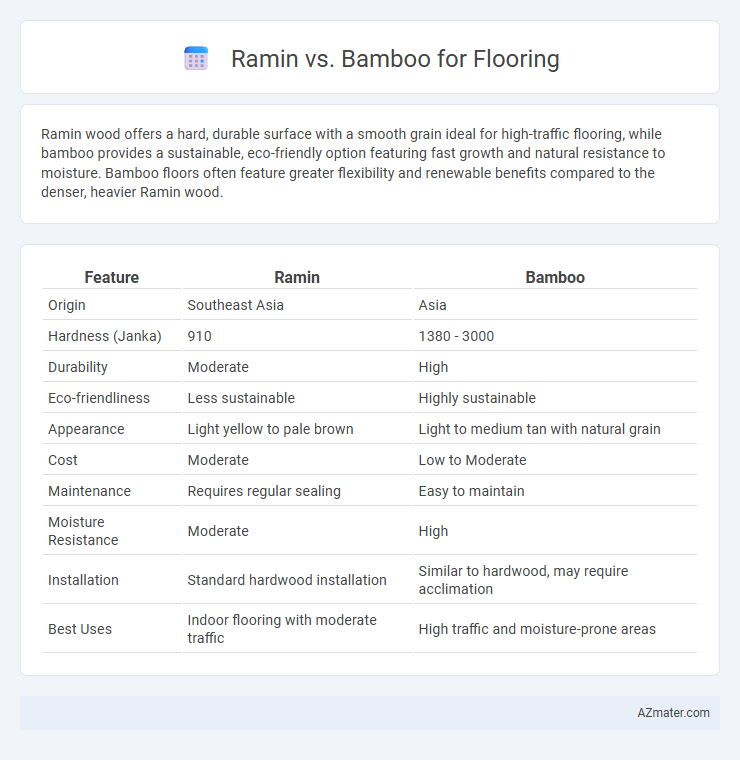Ramin wood offers a hard, durable surface with a smooth grain ideal for high-traffic flooring, while bamboo provides a sustainable, eco-friendly option featuring fast growth and natural resistance to moisture. Bamboo floors often feature greater flexibility and renewable benefits compared to the denser, heavier Ramin wood.
Table of Comparison
| Feature | Ramin | Bamboo |
|---|---|---|
| Origin | Southeast Asia | Asia |
| Hardness (Janka) | 910 | 1380 - 3000 |
| Durability | Moderate | High |
| Eco-friendliness | Less sustainable | Highly sustainable |
| Appearance | Light yellow to pale brown | Light to medium tan with natural grain |
| Cost | Moderate | Low to Moderate |
| Maintenance | Requires regular sealing | Easy to maintain |
| Moisture Resistance | Moderate | High |
| Installation | Standard hardwood installation | Similar to hardwood, may require acclimation |
| Best Uses | Indoor flooring with moderate traffic | High traffic and moisture-prone areas |
Introduction to Ramin and Bamboo Flooring
Ramin flooring, derived from the Shorea genus native to Southeast Asia, is prized for its light color, fine grain, and consistent texture, making it ideal for elegant interiors. Bamboo flooring, harvested from fast-growing bamboo species, offers exceptional hardness, eco-friendliness, and moisture resistance, gaining popularity as a sustainable alternative to traditional hardwood. Both materials provide unique benefits in durability and aesthetics, catering to diverse design preferences and environmental priorities.
Origin and Sustainability of Ramin and Bamboo
Ramin wood, sourced primarily from Southeast Asia's tropical rainforests, is subject to strict regulations due to its vulnerability and slow growth, making sustainability a significant concern. Bamboo, native to various parts of Asia, grows rapidly and can be harvested every 3-5 years without damaging the ecosystem, positioning it as one of the most sustainable flooring materials. The sustainable harvesting practices and fast renewability of bamboo present an eco-friendly alternative compared to the more limited and regulated supply of ramin wood.
Appearance and Aesthetic Differences
Ramin flooring features a warm, light yellow to reddish-brown hue with a fine, straight grain that offers a smooth, uniform appearance ideal for creating a subtle elegance in interiors. Bamboo flooring, known for its distinctive natural pattern with visible nodes and varied color tones from pale blond to rich amber, provides a more textured, contemporary look that complements modern design aesthetics. The aesthetic appeal of Ramin is often described as classic and understated, whereas bamboo delivers a unique, eco-friendly vibe with greater visual contrast between planks.
Durability and Hardness Comparison
Ramin wood, sourced primarily from Southeast Asia, offers moderate durability with a Janka hardness rating around 900, making it suitable for light to medium residential flooring. Bamboo, a rapidly renewable grass, boasts higher hardness levels between 1,200 and 1,400 on the Janka scale, providing superior resistance to dents and wear. Bamboo's dense fiber structure contributes to greater durability, while Ramin's softness requires more frequent maintenance in high-traffic areas.
Installation Process: Ramin vs Bamboo
Ramin flooring offers a straightforward installation process due to its consistent density and smooth grain, allowing for easier cutting and fitting with standard tools. Bamboo flooring, while also manageable, requires careful acclimation to prevent moisture-related issues and may involve a floating floor installation method that demands precise locking mechanisms. Both materials benefit from professional installation to ensure durability and optimal performance, but Ramin's stability often reduces installation time and complexity.
Maintenance and Cleaning Requirements
Ramin flooring requires regular cleaning with mild soap and water to prevent dirt buildup and maintain its smooth surface, while Bamboo flooring demands more frequent sweeping and occasional damp mopping to avoid moisture damage. Ramin is less prone to scratches and dents, making maintenance simpler over time, whereas Bamboo needs protective measures such as using rugs or felt pads to prevent wear. Both materials benefit from periodic refinishing to restore their appearance, but Bamboo's higher susceptibility to humidity requires more vigilant upkeep in moist environments.
Cost Analysis of Ramin and Bamboo Flooring
Ramin flooring typically costs between $4 and $7 per square foot, making it a mid-range option known for its durability and smooth finish. Bamboo flooring ranges from $3 to $8 per square foot, with stranded bamboo offering a cost-effective yet highly resilient alternative. Considering long-term maintenance and lifespan, bamboo often proves more economical due to its fast growth rate and eco-friendly sourcing, while Ramin's higher upfront price reflects its premium hardwood characteristics.
Environmental Impact and Eco-Friendliness
Ramin wood, sourced primarily from Southeast Asia, is often criticized for its environmental impact due to slower growth rates and deforestation concerns, making it less sustainable than bamboo. Bamboo flooring, favored for rapid renewability and carbon sequestration, offers superior eco-friendliness by regenerating within 3 to 5 years and requiring minimal pesticides. Certifications such as FSC or PEFC further support bamboo's status as an environmentally responsible choice for sustainable flooring.
Pros and Cons of Ramin Flooring
Ramin flooring offers a smooth texture and light yellowish-brown color that enhances interior aesthetics, with high durability suitable for moderate traffic areas. Its pros include easy workability, resistance to splitting, and affordability compared to premium hardwoods, making it ideal for budget-conscious projects. However, Ramin is less resistant to moisture and insects, requiring proper sealing and maintenance to prevent warping and decay over time.
Pros and Cons of Bamboo Flooring
Bamboo flooring offers a sustainable and eco-friendly alternative to traditional hardwoods like Ramin, featuring high durability and resistance to moisture, making it suitable for various environments. Its rapid growth cycle ensures a more renewable resource, but bamboo can be prone to scratching and may require regular maintenance to preserve its appearance over time. Although bamboo tends to be more affordable than Ramin, it can vary in quality depending on the manufacturing process, which impacts its lifespan and overall performance.

Infographic: Ramin vs Bamboo for Flooring
 azmater.com
azmater.com